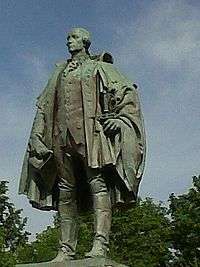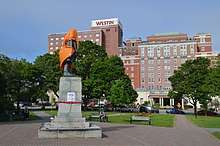Statue of Edward Cornwallis
 | |
| Location | Cornwallis Square, Halifax, Nova Scotia, Canada |
|---|---|
| Designer | J. Massey Rhind |
| Opening date | June 22, 1931 |
| Dedicated to | establishing Halifax and British rule of law |
| Dismantled date | January 31, 2018 |
The Statue of Edward Cornwallis was a bronze sculpture of the military/political figure Edward Cornwallis atop a large granite pedestal with plaques. It had been erected in 1931 in an urban square in the south end of Halifax, Nova Scotia, opposite the Canadian National Railway station. On January 31, 2018, the statue and pedestal were removed on order of the Halifax Regional Council.
Cornwallis was the founder of Halifax (1749) and was Governor of Nova Scotia from 1749 until 1752. Since the 1980s the existence of the statue has generated significant controversy. For Nova Scotia's indigenous people, the Mi'kmaq, the statue had come to symbolize the injustices they had suffered through the colonial period, and up to the present day. To many other Nova Scotians, the statue represented the founding of the city and had local historical value. Historian John G. Reid writes that the conflicting viewpoints centred on the issue of historical memory, that is, "how the past should be publicly remembered."[1]
Construction
The statue was made by J. Massey Rhind and unveiled on June 22, 1931, on the 182nd anniversary of Cornwallis' arrival to Halifax as Lieutenant Governor of Nova Scotia. The statue was paid for primarily as a tourism endeavour by Canadian National Railway, who also paid for the statue of the fictional character Evangeline to promote tourism. Cornwallis was given the title "Founder of Halifax".[2]
Statue symbolism
Historian John G. Reid asserts that the statue reflects the imperialist, colonial times of its creators in the early part of the twentieth century. Reid writes that the creation of the statue "was governed not by history but by a potent mixture of imperialism, a racially-charged triumphalism based on the savagery-civilization binary, state promotion, and an economic agenda."[3] He writes further, "The ideology that had underpinned the raising of the statue had offered a strong and positive answer to any such concerns [of imperialist conquest]- the establishment of Halifax was a triumph of civilization over savagery, and Cornwallis was the city's courageous founder."[2] During one of the speeches at the unveiling of the statue, Cornwallis was described as "a virile, strong, stand fast face with a touch of sternness in it which is usually to be found in the faces of all men who achieve - all leaders of men and all pioneers."[2] The Mi'kmaq militia had effectively executed armed resistance throughout Father Le Loutre's War, preventing the British from establishing a stronghold in Mi'kma'ki. The speeches at the unveiling of the Cornwallis statue played down the effective Mi'kmaq armed resistance, simply giving passing reference to the Mi'kmaq being obstacles to settlement.[4]
Recent discussions and statue's removal
Since the 1980s, the most notable advocate for the removal of the Cornwallis statue from a public space has been Daniel N. Paul, author of the book We Were Not the Savages. Paul has suggested renaming the park Donald Marshall Jr. Memorial Park and replacing the statue with one of Donald Marshall Jr., wrongly convicted of murder in his youth and a fighter for the rights of the Mi’kmaq people.[5]
Reid identifies that Paul's work, along with historians from the 1980s onward, helped to highlight the violence that the British used in the colonizing process.[6] Reid suggests that Paul's work has been part of larger efforts to target Cornwallis in a symbolic manner, "representing the broader reality that colonization was not a benign process in which the significance of indigenous people was just that they were an inconvenient obstacle, but rather was an invasion and - like all invasions - was bitterly resisted."[1]
Reid argues that, even after Cornwallis left, the Mi'kmaw signed the Halifax Treaties from a position of military power, not defeat, as allegations of genocide suggests.[7] There was both a history of bounties on British settler's scalps paid by the French,[8] and a long history of British governors in New England making proclamations against the Mi'kmaq for their raids on British settlements.[9] Cornwallis followed New England's example when, after the Raid on Dartmouth (1749), he created a scalp proclamation that put a bounty on Mi'kmaq men, women, and children, offering money to kill or take them prisoner (1749). Dr Reid says the issue at the heart of the conflict between the British and the Mi’kmaq people was land. “The British were taking territory that had never been given to them.”[10]
Reid states that "historical memory can and should evolve with each succeeding generation…"[2] While there could be new public art of Cornwallis that reflects a contemporary sensibility and the complexity of the man and his legacy, ultimately, Reid indicates his support for moving the existing statue into a museum space and changing public names of buildings (e.g., the Cornwallis Junior High School which was renamed to Halifax Central Junior High).
There is also concern about the message the statue sends about Cornwallis. Dr Reid says, “When you have somebody on a pedestal in public place of that kind, then what you are doing essentially is validating that person.” Reid felt that the continued presence of the Cornwallis statue normalized the colonial process.[10]
In April 2017, the city council voted to appoint an expert panel which would include Mi’kmaq representatives to recommend a way forward to deal with commemorations of Cornwallis in the city.[11] During the Halifax Regional Council meeting, on July 18, 2017, an account from the group called Removing Cornwallis was read by Mayor Mike Savage, with respect to the group's Declaration for a Call to Action. [12]

On July 1, 2017, a mourning ceremony was held at the Cornwallis statue site in Halifax. It was a ceremony to remember the missing indigenous women. It was disrupted by five members of the Canadian Armed Forces, calling themselves members of the right-wing Proud Boys. The five were suspended from the Forces and the Forces' leadership apologized. The incident was used to amplify Dan Paul's allegations against Cornwallis and to support the argument that, despite the wording of the Halifax Treaties, the Mi'kmaw never surrendered to the British and that Nova Scotia is unceded Mi'kmaq lands.[13] On July 15, a group of protesters arrived at the site with the intention of removing the statue. The City of Halifax arrived, covering up the statue with a black tarpaulin. The shroud covered the statue for the duration of when the protesters were at the scene. The City crew removed their covering. However, an orange tarpaulin was attached to the statue to obscure it, later that evening.[14]
On January 31, 2018, the statue was removed after City Council voted 12-4 in favour of moving the statue into storage. Both the statue and the stone pedestal on which it stood were placed in storage.[15]
See also
References
Notes
- 1 2 Reid 2013, p. 36.
- 1 2 3 4 Reid 2013, p. 38.
- ↑ Reid 2013, p. 33.
- ↑ Reid 2013, p. 32.
- ↑ Paul, Daniel N. (August 5, 2009). "A Tribute to Donald Marshall Jr". NB Media Co-op. Retrieved August 25, 2017.
- ↑ Reid 2013, p. 35.
- ↑ Carlson, Kathryn Blaze (September 16, 2011). "European settlers sought 'genocide' on Mi'kmaq: historian". National Post.
- ↑ Drake 1870, p. 32.
- ↑ Drake (1870), p. 134
- 1 2 "The Cornwallis statue debate - Dalhousie Gazette". December 10, 2016.
- ↑ "Halifax mayor speaks out against protesters' plan to remove Cornwallis statue". The Globe and Mail. The Canadian Press. July 11, 2017. Retrieved July 18, 2017.
- ↑ "Halifax Regional Council Action Summary" (PDF). Halifax.ca.
- ↑ "Military's response to 'Proud Boys' clash at Mi'kmaq protest is 'a great step forward': activist". CTV News. July 5, 2017. Retrieved July 14, 2017.
- ↑ "'Offensive and disgraceful': Protesters cheer as City of Halifax shrouds Cornwallis statue". CBC News. July 15, 2017.
- ↑ "'Controversial Cornwallis statue removed from Halifax park". CBC News. January 31, 2018.
Bibliography
- Drake, Samuel G. (1870). A Particular History of the Five Years French and Indian War in New England.
- Paul, Daniel (1993). We Were Not the Savages. Fernwood Press.
- Paul, Daniel. "Gov. Edward Cornwallis : Scalp Proclamation 1749". danielpaul.com.
- Reid, John (2013). "The Three Lives of Edward Cornwallis". Journal of the Royal Nova Scotia Historical Society. Vol. 16.
- "Historical Paper No. 1: Edward Cornwallis" (PDF) (pdf). Halifax Military Heritage Preservation Society. 28 November 2016.
External links
| Wikimedia Commons has media related to Statue of Edward Cornwallis. |